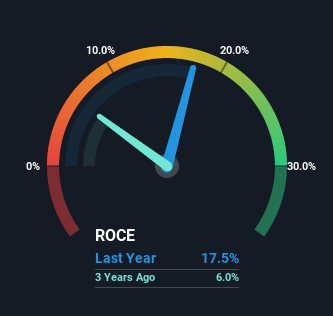- United States
- /
- Oil and Gas
- /
- NasdaqGS:BRY
We Like These Underlying Return On Capital Trends At Berry (NASDAQ:BRY)

If you're not sure where to start when looking for the next multi-bagger, there are a few key trends you should keep an eye out for. Ideally, a business will show two trends; firstly a growing return on capital employed (ROCE) and secondly, an increasing amount of capital employed. Basically this means that a company has profitable initiatives that it can continue to reinvest in, which is a trait of a compounding machine. So when we looked at Berry (NASDAQ:BRY) and its trend of ROCE, we really liked what we saw.
Return On Capital Employed (ROCE): What Is It?
For those who don't know, ROCE is a measure of a company's yearly pre-tax profit (its return), relative to the capital employed in the business. Analysts use this formula to calculate it for Berry:
Return on Capital Employed = Earnings Before Interest and Tax (EBIT) ÷ (Total Assets - Current Liabilities)
0.17 = US$244m ÷ (US$1.6b - US$234m) (Based on the trailing twelve months to December 2022).
Thus, Berry has an ROCE of 17%. In absolute terms, that's a pretty normal return, and it's somewhat close to the Oil and Gas industry average of 21%.
View our latest analysis for Berry

In the above chart we have measured Berry's prior ROCE against its prior performance, but the future is arguably more important. If you'd like, you can check out the forecasts from the analysts covering Berry here for free.
SWOT Analysis for Berry
- Debt is well covered by earnings and cashflows.
- Dividends are covered by earnings and cash flows.
- Dividend is in the top 25% of dividend payers in the market.
- No major weaknesses identified for BRY.
- Good value based on P/E ratio and estimated fair value.
- Annual earnings are forecast to decline for the next 3 years.
How Are Returns Trending?
We're delighted to see that Berry is reaping rewards from its investments and has now broken into profitability. The company now earns 17% on its capital, because five years ago it was incurring losses. While returns have increased, the amount of capital employed by Berry has remained flat over the period. That being said, while an increase in efficiency is no doubt appealing, it'd be helpful to know if the company does have any investment plans going forward. Because in the end, a business can only get so efficient.
The Key Takeaway
In summary, we're delighted to see that Berry has been able to increase efficiencies and earn higher rates of return on the same amount of capital. Since the stock has only returned 11% to shareholders over the last five years, the promising fundamentals may not be recognized yet by investors. So with that in mind, we think the stock deserves further research.
If you want to know some of the risks facing Berry we've found 3 warning signs (1 is a bit concerning!) that you should be aware of before investing here.
If you want to search for solid companies with great earnings, check out this free list of companies with good balance sheets and impressive returns on equity.
Valuation is complex, but we're here to simplify it.
Discover if Berry might be undervalued or overvalued with our detailed analysis, featuring fair value estimates, potential risks, dividends, insider trades, and its financial condition.
Access Free AnalysisHave feedback on this article? Concerned about the content? Get in touch with us directly. Alternatively, email editorial-team (at) simplywallst.com.
This article by Simply Wall St is general in nature. We provide commentary based on historical data and analyst forecasts only using an unbiased methodology and our articles are not intended to be financial advice. It does not constitute a recommendation to buy or sell any stock, and does not take account of your objectives, or your financial situation. We aim to bring you long-term focused analysis driven by fundamental data. Note that our analysis may not factor in the latest price-sensitive company announcements or qualitative material. Simply Wall St has no position in any stocks mentioned.
About NasdaqGS:BRY
Berry
Operates as an independent upstream energy company in the western United States.
Undervalued with solid track record.
Similar Companies
Market Insights
Community Narratives




